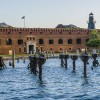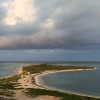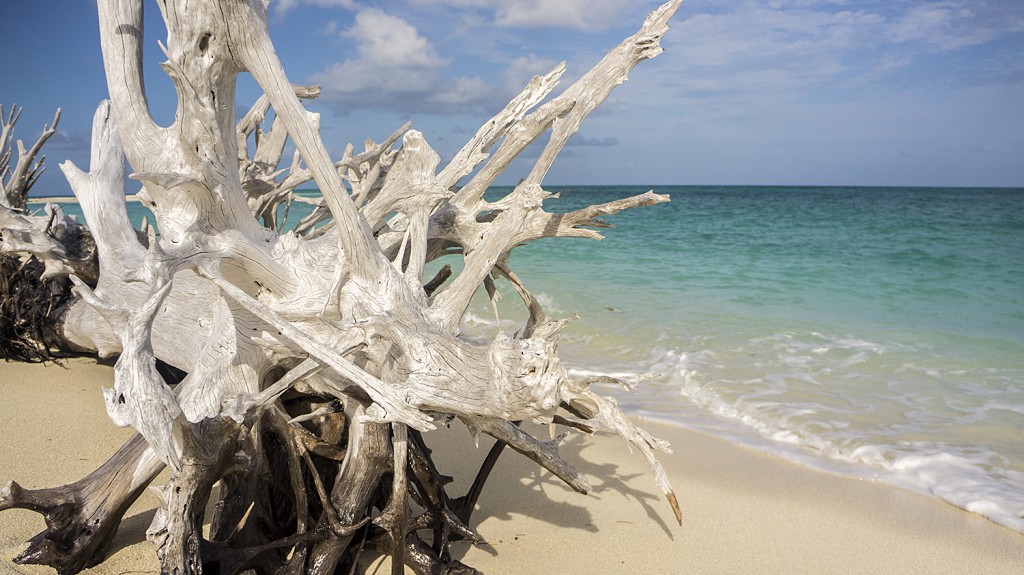After saying goodbye to Mike Feeley and Lee Richter in Miami, I hopped on a flight to Key West to start the next leg of my journey to the Dry Tortugas. I had been to Key West once before this January, for a field trip on the SEA vessel Corwith Cramer, and I can confidently confirm that the fake people standing atop the airport are even more disconcerting at night. Dry Tortugas National Park lionfish interns Ryan Lind and Lee Qi picked me up from the airport and brought me to Key West government housing. Everyone at Dry Tortugas (which those in the know refer to by its NPS abbreviation DRTO, pronounced “dirt-o”) works a ten days on, four days off schedule, and Ryan and Lee Qi were in the middle of their time off. We would have the next day in Key West to get groceries and pack, and would head out on the ferry early the following morning.
After a Publix run and poaching wifi from the tiny Key West Public Library, we went sightseeing: after determining that the Hemingway house tour was outside the scope of our intern budget, Ryan and I visited Fort Zachary Taylor State Park and associated beach. Fort Zach served as a teaser to my next ten days, as its design and construction are nearly identical to those of DRTO’s Fort Jefferson, albeit on a much smaller scale. Afterward we met up with Lee Qi for some people watching on Duval Street before heading to Mallory Square for the sunset celebration. As we stood entranced by the contradictory incantations of the French Canadian Cat Man, I got a call from the ferry announcing that due to a steering problem we wouldn’t be going out the next morning. The interns needed to use this as a work day for data entry, so under the supervision of DRTO Biological technician Kayla Nimmo we headed to the NOAA-Mote Marine Eco Discovery Center for a work space. While they worked I did some eco discovering, and Lee Qi lent me her bike to check out the Key West Aquarium. That night, Ryan sautéed some lionfish they had brought home from the park. I hadn’t gotten to try it in Biscayne and have nothing but positive reviews. Seafood doesn’t get much more sustainable than this!
The next morning, the ferry Yankee Freedom II was up and steering so at dawn we loaded our dive gear and coolers of groceries. As we clustered around a table and chatted to the crew, a flood of visitors in various stages of snorkel preparedness filled both decks of the ferry. After two and a half hours of open water, the brick walls of Fort Jefferson appeared on the horizon. This Civil War-era fort would be my home for the next ten days.
Dry Tortugas National Park is almost too beautiful. I’m living in a cliché of soft white sand and turquoise waters, with sunsets that set the fort’s brick walls ablaze. Spanish explorer Don Juan Ponce de Leon discovered this collection of seven islands in 1513 and named them for the abundance of sea turtles he found there. The “Dry” clarification was added later to warn sailors that the islands lack a source of fresh water. Incorporated into the United States with the Louisiana Purchase, the islands were clearly a strategic fortress area for their location and natural protected harbors. Construction of Fort Jefferson began in 1840 on Garden Key, and the still incomplete fort became a Union stronghold during the Civil War, used to cut off supplies to the South. Never fired upon, it became a military prison for Union deserters. The fort’s most famous prisoner was Dr. Samuel Mudd, whom fellow non-history majors may recognize, as I did, primarily from Nicolas Cage explaining the origin of the phrase “his name is mud” in the classic film National Treasure 2. Dr. Mudd set John Wilkes Booth’s broken leg after Booth assassinated Abraham Lincoln, and while his degree of involvement in the conspiracy is unclear, he was sentenced to life imprisonment at Fort Jefferson. After an initial rocky start involving an abortive escape attempt Dr. Mudd rose to the ranks of Most Valuable Prisoner after his heroic assistance with a Yellow Fever outbreak and was eventually pardoned and freed. Franklin Delano Roosevelt pronounced the fort a National Monument in 1935, and the surrounding rich ecological resources were also protected in 1992 when the area became a National Park. Due in large part to its remoteness—the closest land is Key West, 70 miles away—the area is a haven for birds and marine life, with biodiversity and abundance that provide the same glimpse into the past as the historically preserved fort. For the last month everyone has been telling me how wonderful and healthy the reefs are here compared to the relative desolation of the VI and Biscayne, and as we arrived I was itching to get into the water.

Modeled after British castles, the entire fort is surrounded by a moat. Allegedly it hosts a resident crocodile, but I have yet to see him.
As we bustled about unloading the ferry, transferring our belongings to our fort housing, and preparing our dive gear, Kayla approached us with somber news. Following a dive incident involving rebreather equipment malfunction last November (from which thankfully everyone fully recovered), the National Park Service had issued a scientific diving stand-down, effective that morning and holding until the NPS scientific diving policy was rewritten and approved, and individual park dive programs underwent the necessary changes and training to resume diving. Kayla explained that the possible way around it would be to dive under the stricter regulations for government commercial diving, but until we were trained and approved and had all the necessary equipment for commercial dives, there would be no diving in DRTO. Crestfallen, we looked longingly at beautiful conditions—no wind and the sea glass to the horizon, the first such good weather the other interns had seen all season. While we of course recognized the importance of revising the dive policy to avoid future incidents and keep everyone safe, we couldn’t help but feel disappointed and indignant about the timing. As I’ve seen over and over in the past month, the vagaries of weather and technology make field days precious. Losing good weather days in the height of research season was a blow, not just because diving is more fun than office work but also because it limits data collection and may keep projects from completion. The stand-down may last anywhere from a few weeks to months, likely throwing a wrench into science diving programs across the National Park system.

Sea turtle intern Marc Fruitema, Ryan, Biological technician Kayla Nimmo, and lionfish intern Lee Qi can barely contain their excitement about OSHA regulations.
Kayla was incredibly on top of doing everything she could to get us commercial dive certified. Within the hour she was inventorying the equipment we would need and collecting anything that needed to be inspected or serviced, and she spent the next day putting together our training course and exam. We picked up sea turtle intern Marc Fruitemi from his housing on Loggerhead Key, and spent the afternoon immersed in the delights of OSHA (Occupational Safety and Health Administration) regulations. We all of course passed the certification test with flying colors, but were again stymied as subsequent communications revealed that although for purposes of practicality the NPS usually ignores outdated OSHA standards that require the use of specific equipment that is now no longer manufactured or serviced, for the stand-down we would need to be strictly OSHA-compliant and thus lacked the mandated equipment to dive.
Determined not to squander the gorgeous weather and our limited time in the park, your plucky team of ‘terns scouted out shallow sites to hunt lionfish via snorkeling and free diving. I had never officially tried free diving before other than short dips while snorkeling, and was eager to give it a whirl. We went to check out some isolated coral heads, or as we call them, “nubbins,” in 20-40 feet of water. The visibility wasn’t great, so on my first foray in it felt a bit like going down the rabbit hole to swim blindly through clouds of particulate until suddenly the reef sprang into view, vibrant and clear. There is something magical about moving silent and unencumbered through the water on a free dive, experiencing the world below in brief vignettes. I’m not sure I’m completely sold, though—I do enjoy breathing! What is certain is that DRTO lives up to the hype: this is fish heaven. Here are all the missing snappers and groupers from the VI, and they’re enormous. Curious red groupers come right up to us, and on a few sites I was ecstatic to come face to face with a goliath grouper. Five hundred pounds of fleshy, thick-lipped, beady-eyed fishy goodness—what could possibly be more lovable?
The DRTO lionfishers have been using timed surveys to collect data on catch per unit effort, and unfortunately free diving wasn’t compatible with this survey type. We weren’t able to systematically look for lionfish, it was difficult to estimate the timing, and with poor visibility we couldn’t see one another well enough for safe diving. We sadly concluded that free diving would not be the answer.
Fortunately, there’s plenty of work to be done on land. The Dry Tortugas continue to live up to their name as a hotspot for sea turtle nesting. The park is trying to make Loggerhead Key an index beach for loggerhead turtles, which means it must be monitored daily. Marc usually patrols the island in the mornings but is on a different 10-4 rotation than Ryan and Lee Qi, so on his lieu days we would take over. Marking nests is a more casual affair here than in Biscayne since there are so many and raccoons aren’t an issue. Rather than digging up each nest to confirm eggs and covering it with screens, we simply mark each possible nest with a PVC pipe stake identifying the nest with the date, species, and likelihood of a nest on a scale of 1 (a false crawl, which doesn’t merit a stake) to 6 (when the observer sees the turtle laying the eggs). Stakes are also marked with colored tape indicating the month and week of laying to quickly identify nests that may have hatched. We record the GPS coordinates of each nest, and keep track of how nests have been affected by waves, other turtle activity, and invasive plants like Australian Pine. Also unlike Biscayne, it’s easier to find nests and false crawls here because turtles leave identifiable tracks on the continuous sandy beaches, and lots of them: on our first morning we found eleven nests! This was an unusual amount of activity, but this has been a record year so far, and patrolling for turtles is never a quick stroll along the beach. The expansive sand seems to encourage some particularly finicky turtles to travel up, down, and across the beach in meandering turns and loops, sometimes digging several cavities before nesting.
Following their tracks in and out of the water can be quite a trek, and as the blinding sun rises higher in the sky we aren’t above berating the turtles for their incompetent nesting. The heavy turtle activity adds a quasi-forensic air to the walk as we attempt to discern who nested where. As turtles deliberately mask their tracks as they cover their nests, and often cross and mask other turtles’ tracks in the process, this can be a difficult task! On the eleven-nest day especially we spent nearly as much time puzzling as we did walking. As we head out and load the boat we usually take a few minutes to watch the tarpon and cobia that cut sharp lines through the swirling bait ball surrounding the dock, now and then abruptly accelerating into silvery attack.
We’re eagerly awaiting updates about the stand-down and crossing our fingers that we’ll be able to find a way to dive! In the meantime, we have plenty of crazy turtles to keep us busy, sunrises and sunsets to watch, and another week of fort life ahead.























Brett. I really enjoyed your first posting on the time at DRTO. I’m glad you all finally got the chance to dive. You did a great job in your description of the history of the park, but I caught one error I wanted to point out to you. The 1935 proclamation that established Fort Jefferson National Monument included not just the Fort and Garden Key, but all the islands and a large expanse of surrounding waters. It appears that someone just drew a large oval on the USCGS charts, and that was the legal boundary until legislation established the National Park. I’m not sure just how the old and new boundaries compare, but it’s fortunate that the original proclamation provided protection to the entire area. Otherwise, who knows what might have become of the marine resource. Good luck on your travels.
Dear Brett,
My name is Martin Palmer. I lived in South Miami for Seven years and in 2005 moved to Hong Kong where I have now been living for Seven years. I really enjoyed your article about Fort Jefferson and your adventures there. I enjoy swimming and reading articles about the ocean and its marine life. I look forward to reading more of your blogs and wish you a great career ahead. You now have a blog follower in Hong Kong.
With kind regards,
Martin